
Esther Njeri has a rare skin condition that has covered almost her entire body, save, thankfully, the face. Doctors say there is no cure, so she has to learn to live with it. Photo/WIKIMEDIA COMMONS
By JOY WANJA MURAYA jwanja@ke.nationmedia.com
Posted Wednesday, February 29 2012 at 00:00
Posted Wednesday, February 29 2012 at 00:00
For a person whose body is covered with ghastly layers of aging and dead skin, 35-year-old Esther Njeri Kimani seems rather too comfortable, almost snug, with the condition.
She could have decided to languish in seclusion, to resign to her “fate” and just let her life roll by, but she won’t have any of that.
“This is me,” she says, smiling as she coyly rubs her hands together. “This is me, and I can’t run away from myself.”
At first sight, she looks like the ordinary 30-year-old next door. Slightly built and equally shy, she loves the camera lens. And the lens loves her back. She seems happy, sounds felicitous even.
Basically, she is the girl sitting next to you in the matatu... until she stretches her hand to greet you. Then you notice the skin condition she has learnt to live with and you squinch in your seat.
Her palm is smooth, but the back of her hand bears uneven scaly skin punctuated by black marks that overlap each other. The creases on her hands and legs are pronounced, giving an impression she has not oiled her skin in a long, long time.
But oil herself she does, only that Ichthyosis, a debilitating skin ailment that she has suffered since childhood, does not give the outer layer of her skin the time to develop a sheen like the rest of us.
Disfiguring condition
The disfiguring condition is more concentrated at the elbow, knee and ankle joints. Luckily, her face has been spared.The disease has covered her from the nape of her neck to the tip of her toes, and that is why you are most unlikely to see her in a short-sleeved blouse or T-shirt.
Dr E N Kamuri, a dermatologist based at the Kenyatta National Hospital, says medical experts are yet to figure out the cause of this condition. That means no one has found a cure for it yet, so Esther must learn to live with it.
Dr Kamuri says Ichthyosis is a family of genetic skin disorders characterised by dry, scaling skin that may be thickened or very thin. The prefix “ichthy” is taken from the Greek root for the word “fish”.
“The disease usually presents at birth, or within the first year, and continues to affect the patient throughout their lifetime,” he says. “It affects one in every 250 newborns.”
For more than 20 years, Esther struggled with the effects of this condition on her life. She barely pulled through cold days, and July, the coldest month in Kenya, proved a nightmare.
But over the last one decade she has learnt to manage the condition by moisturising her skin often and keeping it covered to protect it from the elements.
Her school days, she says, were a nightmare and the stares from the general public unending. Few peers understood her condition, which had for years gnawed on her self-esteem.
“My childhood was a very painful experience. But I think my parents were more affected by the condition than I was because they could not understand what was happening. I was a bit naive then,” she says.
No cure
When she finally grew up, she decided to seek medical advice on her own, and so she sought the services of a dermatologist.
“I wanted to know what was happening,” she says. “I may have been born with this condition, but I had not yet resigned myself to it, so I knocked on a doctor’s door and asked him what the hell was wrong with me."
“They looked at me, did several tests, then broke the gory news... in bits. I had ichthyosis. There was no cure. I had to learn to live with it."
“From that day on, I resolved to accept the situation and turn my life around, so I started cultivating a new brand of self-image and confidence. Today, if you ask me, Ichthyosis is just a part of me. It does not define my personality.”
At about the same time, she got a sponsor who invited her to Scotland for tests. She lived in the European country for two and half years, and by the time she came back home, she had learnt how to manage the condition.
Though the itching has stopped, she bears scars of the disease and wears long-sleeved sweaters and socks to cover up. She suffered from depression in her teen years and stress in her college years, but she has now embraced the importance of self-worth.
“I had a very low self-esteem, but with time I have become a confident woman,” she says.
Good tidings
That confidence has spawned some good tidings for her, and even though she does not reveal much, she says her life has changed for the better since she resolved to make the best of her condition.
“For one, I found a man who is compassionate, understanding and supportive,” she says. “He fully understands my condition and has taught me a lot.” Esther does not reveal much about her knight in shining armour, other than that he is Austrian.
Before the Austrian arrived into the scene, she had been in a seven-year relationship and engaged for marriage, but she did not eventually walk down the aisle due to what she calls “spiritual differences”.
“I was born-again, he was not,” she explains. “My Christian faith is my anchor. The Lord gives me the strength when I feel down, so I would want my partner to share the same beliefs.”
Her current partner is a born-again Christian and they “share scriptural Bible verses” whenever they communicate.
“After fighting all those emotions of feeling unloved and stressed, today I’m happy, intelligent, sociable, and I enjoy life to the fullest,” she beams. So social has she become that for one year she worked as amatatu conductor, a job she says had its own version of bitter-sweet moments.
“I plied Route 30 (Uthiru-Nairobi), and the best part of the job was that I would make new friends every day,” she says. However, she was not spared the constant harassment by traffic police officers that is the bane of the trade, and sometimes the never-ending competition with male conductors left her emotionally and physiologically drained.
After a month on the job, she resigned and started a second-hand clothes business, and this is what feeds her and pays her rent today.
Patients ostracised
Dr Kamuri says patients with this condition are often ostracised, and that cases of isolation, low self-esteem and depression are common.
The skin specialist advises parents to encourage their sons and daughters with the condition to have a positive attitude in life so that they can deal with the situation better when they are adults.
“We counsel parents and those interacting with persons suffering the condition to understand that there is no cure, but one can lead a normal life by constantly moisturising the skin,” says Dr Kamuri. “Caring for Ichthyosis is as much about looking good as feeling good,” he adds.
A normal life
Esther uses a soft cloth while bathing, and the water has to be warm. “After that, I constantly apply skin lotion to prevent drying up, which is a very uncomfortable feeling. Otherwise, I lead a normal life.”
She is grateful to her close friends and family, whom she says have been a pillar of strength for the last three and a half decades she has been battling the disease.
Every now and then, she logs onto the website http://tinyurl.com/7vudo7c, which brings together persons with Ichthyosis. There, they share their experiences with the condition and encourage each other to soldier on.
“It’s a tightly-knit community that has been of great help to me,” she says.
So what do you do when you meet her on the streets and notice the rough skin on her?
“Don’t stare,” she pleads. “Ask.”
Touched? Send your comments to dn2@ke.nationmedia.com









